|
1
|
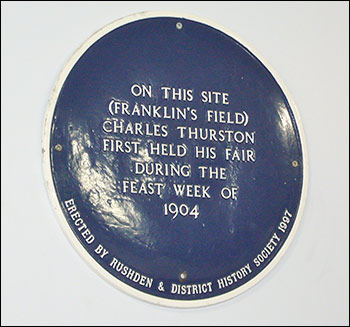 Park in one of Rushden's free car parks and walk northwards along the High Street to the Asda supermarket. Park in one of Rushden's free car parks and walk northwards along the High Street to the Asda supermarket.
Inside the foyer is this plaque to Charles Thurston. The area, known as ‘Franklins-Fields’, was where Thurston’s fairground first came in September 1904, when attractions were Swings, Aunt-Sallies, Shooting Galleries, Round-a-bouts, Boxing-Booths, etc. Most popular were the Switchback Ride and Cinematograph.
|
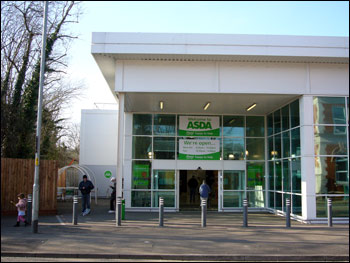 |
|
2
|
Walk back along the High Street. Cross Station Road and just before the Railway Inn once stood 'Stonehurst'.
Stonehurst was a late Victorian, popularly known as the Belgian House because of its connections with the first world war. It was used to house Belgian refugees, the first 19 arrived in October 1914, and were entertained by the Rushden Belgian Relief Committee. In an air raid on 3rd October 1940, this house was hit by the same ‘stick’ of bombs that did much damage to Alfred Street School. Originally built as a brewery store and wine warehouse by Praeds Brewers. After the refugees returned home it was converted into a house, lived in by various families, notably the Wheeler’s, who resided there for 30 years.
Walk along the High Street a few more paces and your will find the Railway Inn on your right.
|
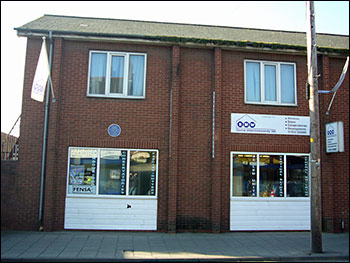 |
|
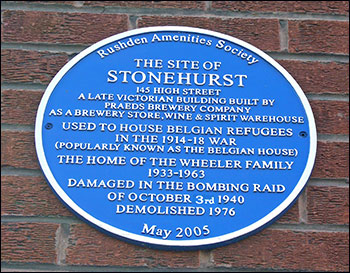 |
|
3
|
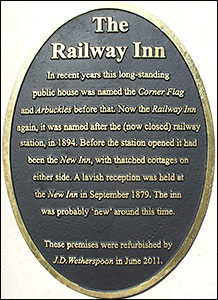 Originally called the New Inn it changed to the Railway Inn when the railway came to Rushden. During the 1980s it was renamed several times. This plaque was affixed, by J D Wetherspoon, to commemorate the inn's history, and their 2011 refurbishment and they reverted once again to the Railway Inn . Originally called the New Inn it changed to the Railway Inn when the railway came to Rushden. During the 1980s it was renamed several times. This plaque was affixed, by J D Wetherspoon, to commemorate the inn's history, and their 2011 refurbishment and they reverted once again to the Railway Inn .
|
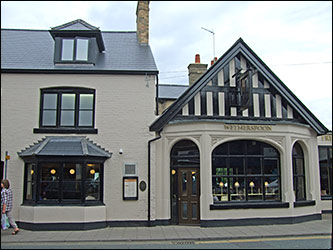 |
|
4
|
Return and walk back towards Asda and turn left down Station Road past the entrance for the 'Splash Pool' and after approx 400yds turn left into Moor Road. A short way along on your right is a new block of flats on the site of the Benjamin Ladds factory.
Benjamin Ladds shoe factory was on this site from 1891 until 1971, and then demolished to make way for this block of flats.
It is recorded that they made Boots and Shoes for men. No mention of footwear for Ladies, a curious situation for the world of today. Like so many of the factories in the town it was a family run concern employing about 75 people and according to records Benjamin’s descendants, Benjamin Hugh Ladds and Hugh Selby Ladds, were on amicable terms with their workforce.
Further along Moor Road (same side) is terraced house No17.
|
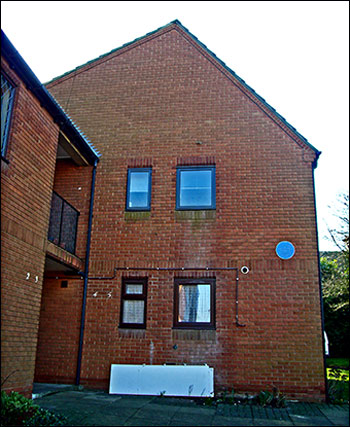 |
|
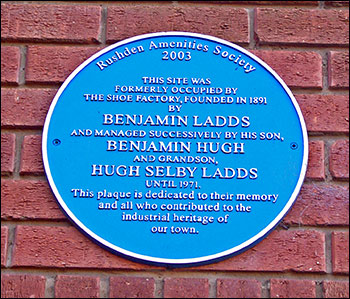 |
|
5
|
Mr. Norman or “Reg.” as he was known to the people of Rushden, probably never thought he would be recognised by the erection of a “Blue Plaque”. A local man who loved listening to and talking in the local dialect, his trade was making leather washers at premises in College Street, unfortunately no trace of which remains. There are few people alive today with first hand knowledge of the dialect spoken in the shoe factories of yesteryear, popularly known as “Rushdenese”. Reg. decided to try his hand at writing poems in this strange to us language, (but can be understood with some concentration). He composed “Air Ada” as a weekly feature in the local newspaper. He had no books published, but examples of his work have been in various publications over the years. He wrote nothing malicious or derogatory, but chose to depict life in his inimitable style.
Continue to the end of Moor Road and turn left into Fitzwilliam Street. Walk down the hill, turn right, cross Duck Street and proceed to the far corner of the car park where the blue plaque can be seen on the side wall of the Pizzeria Venezia Restaurant.
|
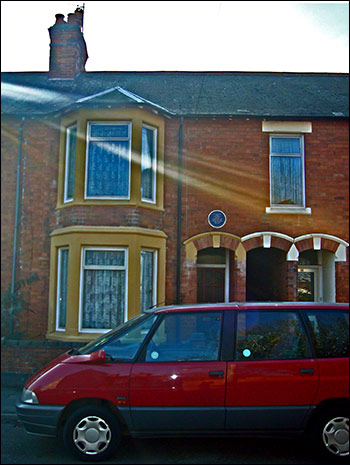 |
|
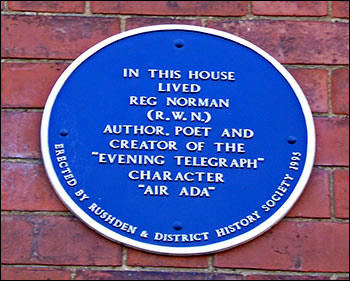 |
|
6
|
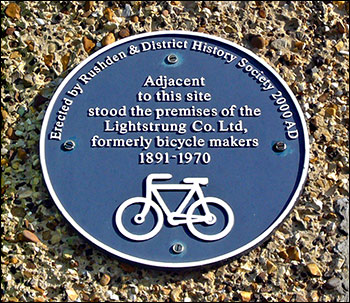 The Lightstrung company began in 1886, manufacturing pedal cycles, and later on motor-cycles. In 1902 the Lightstrung Cycle and Engineering Works was at 16 Church Street Rushden. The name originated as the bicycles were both “Light” and “Strung” (Ruzdin for ‘strong’). [A cycle is at Rushden Station Transport Museum.] Later it became a motor garage. The company closed in 1970. The Lightstrung company began in 1886, manufacturing pedal cycles, and later on motor-cycles. In 1902 the Lightstrung Cycle and Engineering Works was at 16 Church Street Rushden. The name originated as the bicycles were both “Light” and “Strung” (Ruzdin for ‘strong’). [A cycle is at Rushden Station Transport Museum.] Later it became a motor garage. The company closed in 1970.
[The name lives on with locals, as most coach tours had “The Lighstrung” as the pick up point, but now renamed Skinners Hill]
|
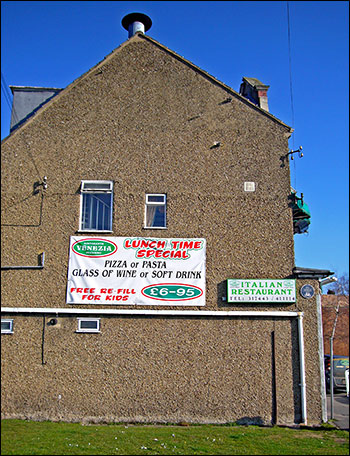 |
|
7
|
Walking around to the front of the restaurant in Church Street you will see the plaque for the 'John White 2nd factory.'
John White’s second factory was here from 1920 until 1922. It was also the head office. He started making shoes in 1919 in a former paint shop until he was able to purchase these premises, so this was his first ‘proper factory’. He continued to prosper, expanding his workforce and premises, to peak in 1941, when three million pairs of boots and shoes were produced annually. In 1937 perhaps his best known factory was built in Lime Street, and by 1941 he owned nine factories employing two thousand workers. The main production was supplying the military with footwear during wartime, both in the Spanish civil war of 1936-1939 and the second world war. By 1941 the factories had produced eight million pairs for the armed services.
Continue up Church Street and take the second left into Alfred Street. Walk along this street of terraced houses/small businesses and Alfred Street School can be seen at the far end. Pass the school and turn left into College Street to see the plaque on the school wall. You may also enter the memorial garden kept neat and tidy by the pupils.
|
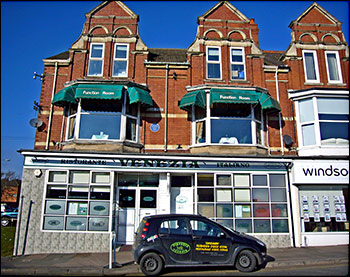 |
|
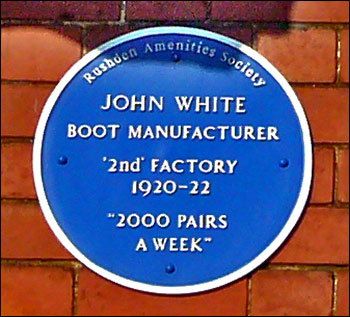 |
|
8
|
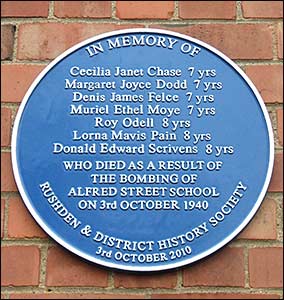 Alfred Street School was bombed mid-morning on 3rd October 1940. 4 adults and 7 children were killed and 40 people injured. The air raid shelter in the school playground was hit, luckily the air raid warning had not sounded and the shelter was empty. Bombs from the same stick also damaged Cave's factory (now Wilkinsons) and killed 4 men. Alfred Street School was bombed mid-morning on 3rd October 1940. 4 adults and 7 children were killed and 40 people injured. The air raid shelter in the school playground was hit, luckily the air raid warning had not sounded and the shelter was empty. Bombs from the same stick also damaged Cave's factory (now Wilkinsons) and killed 4 men.
|
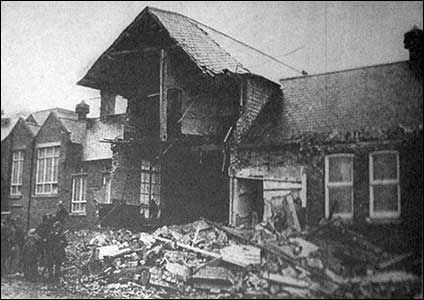 |
|
9
|
From here walk up the hill (past Flutters Bingo Club) towards the High Street and turn left. Walk along the High Street to the next turning on your left......West Street.
John Harrison was born at Bozeat on 15th October 1888, son of Arthur and Martha, living in High Street. In 1907 Jack joined the Army, and when he left in 1910 he came to Rushden to live with his parents at 12 West Street. He won the Lonsdale belt in 1912. Joining up again to serve in WWI, he continued to box in the army. After the war he had a successful boxing career, before returning to work for Rushden Urban Council. Always known as Jack, he died in 1970 aged 82. The Blue Plaque to commemorate Jack's boxing career was unveiled on October 27th 2012.
Return along High Street, to the next turning on your left, Queen Street, continue up and cross over Rectory Road, into the next section of Queen Street.
|
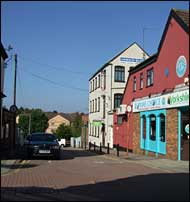 |
|
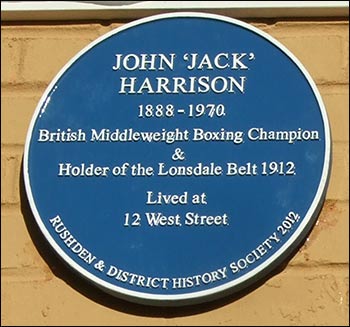 |
|
9a
|
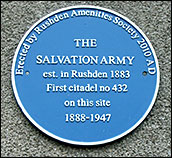 On the corner there is a blue plaque to mark the original site of the Salvation Army barracks. On the corner there is a blue plaque to mark the original site of the Salvation Army barracks.
A few houses up on the right:
No. 26 where a blue plaque was unveiled in 2018, to mark the centenary of the death in WWI of Walter Tull. |
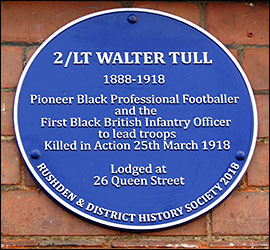 |
|
10
|
Return to High Street, turn left, past College Street and the Rose & Crown to No 30, the former Evening Telegraph office.
The first shoe factory of John Cave was established in 1850 but fate decided that the following years would be calamitous. In April 1877 the fire brigade was called out at midnight to attend a fire at the factory. But by the time they arrived it was too late, and the factory was destroyed. The loss estimated to be in the region of £3,000 pounds. A second tragedy was to occur a few days later when Mr Elias Cave was killed by a falling wall whilst inspecting the damage. A new factory was built on the original site and adjoining land. One of the largest shoe factories in the county; 8,000 pairs of shoes per week were made in 1889 and the workforce was 600+. Following another fire, in 1901, a new factory was built in College Street.
A few yards further along the High Street is 'Mrs B's' sandwich shop with a 'blue' plaque on the adjacent pilaster.
|
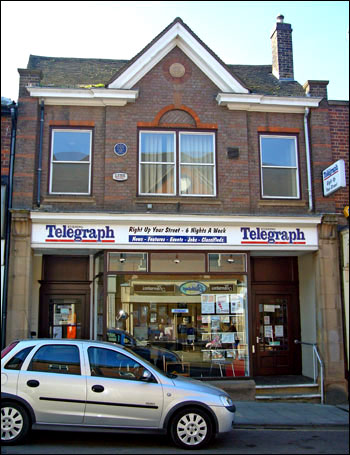 |
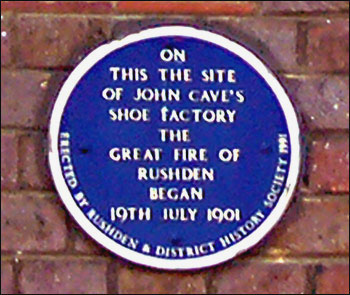 |
|
11
|
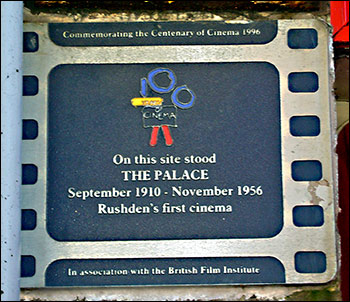 This plaque is situated at the entrance to the old Palace cinema which was opened on September 19th 1910. The main auditorium extended through to Alfred street. The first programmes consisted of live variety and cinema shows. Admission prices were 2d, 4d and 6d, with seating for 543 people. The cinema generated its own electricity using two oil powered engines. This plaque is situated at the entrance to the old Palace cinema which was opened on September 19th 1910. The main auditorium extended through to Alfred street. The first programmes consisted of live variety and cinema shows. Admission prices were 2d, 4d and 6d, with seating for 543 people. The cinema generated its own electricity using two oil powered engines.
“Talkies” came in 1930, when admission prices were 6d, 9d, and 1/- in the stalls, 1/3 and 1/6 in the balcony.
|
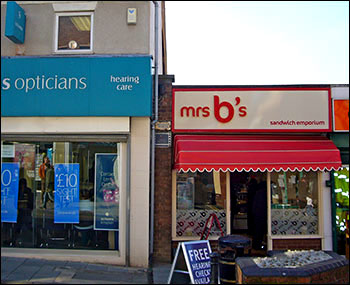 |
|
12
|
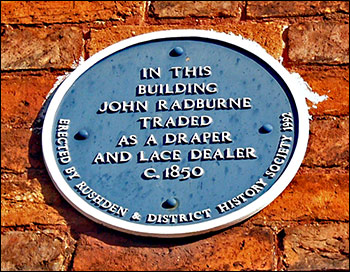 Further along opposite 'Boots the chemist 'is No.12 High Street. Further along opposite 'Boots the chemist 'is No.12 High Street.
This is one of the oldest premises in Rushden. It was used by John Radburne in 1849 for the purpose of buying and selling lace. At that time a great number of the women in the district made lace at home and therefore needed an outlet for their work. John Radburne realised this and also saw the possibilities of selling their products on for a profit, as well as providing the raw materials for them to use. After John died his two sons carried on trading, but it appears that they were not as enthusiastic as their father and the business slowly declined.
|
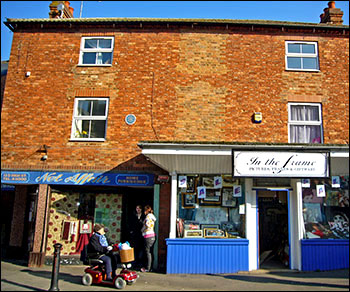 |
|
13
|
Re-cross the High Street and walk a few yards to view No.19.
The site of the first of Co-op shop in Rushden. It was built in 1878, (although a Co-operative business was started in Rushden long before that, kept by a Mr. Denton but unfortunately it failed and was closed down in June 1860). A new Co-op in 1876 was managed by Mr. Darnell and for the first two years he conducted the business from his front room, until 19 High Street was built in 1878. He lived where Wymington Road joins with Bedford Road. His first wage was sixpence in the pound of sales.
Continue to the end of the High Street and turn left up Newton Road, over the traffic light junction and contine up the hill.
Carry on past the 'Athletic Club', Newton Road School and Hove Road and to No 103 on your left hand side.
|
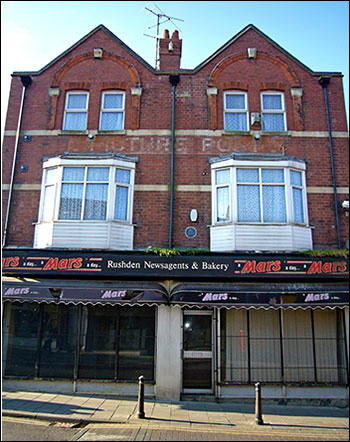 |
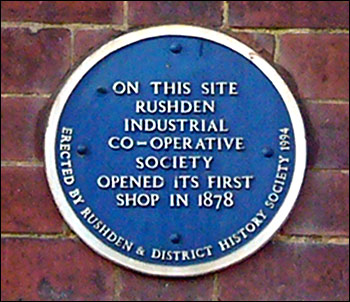 |
|
14
|
On 21st March 2009, Rushden & District History Society put up a plaque on No 103 Newton Road to commemorate the work of Alice Unwin Muxlow. This was where she had lived when she moved to Rushden with her husband who was the manager of the Midland Bank. Alice worked tirelessly throughout the war leading a team of Women's Voluntary Service workers who looked after many aspects of social work and welfare,and made the arrangements for the evacuees here during WWII. Alice was the first lady chairman of the Council in 1946. |
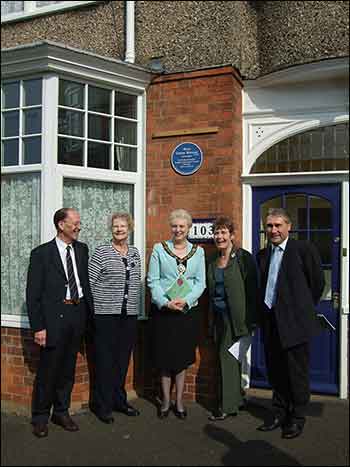 |
| 14a |
Cross Newton Road and after a few steps along Oswald Road turn right into Roberts Street. Half way down on the right:
The terraced houses that once stood here, were demolished after severe bomb damage in 1940, when 4 people were killed. The plaque was unveiled by the grandson of Mrs. Harriet Elmer, who was one of those killed, along with her daughter Betty.
Proceed to the end of Roberts Street. Turn left into Grove Road and No 51 is on your left just past and adjacent to the old factory building. |
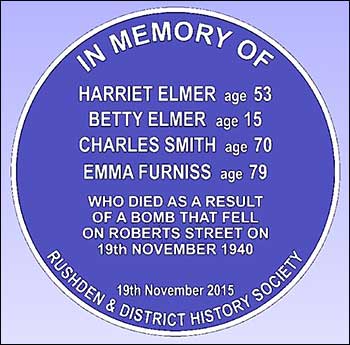 |
|
15
|
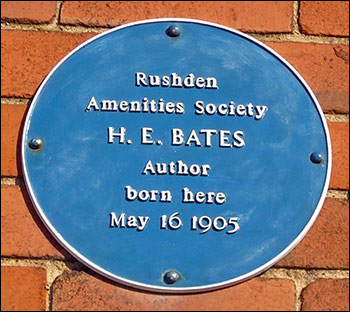 Amongst his works of 126 novels, 323 short stories and 194 essays, articles, etc. are:- ‘The Jacaranda Tree’, ‘Oh! To be in England’, ‘Fair Stood the Wind for France’ and, most probably his most well known book, ‘The Darling Buds of May’. H E Bates also wrote under the pseudonym Flying Officer ‘X’ for his military novels. Amongst his works of 126 novels, 323 short stories and 194 essays, articles, etc. are:- ‘The Jacaranda Tree’, ‘Oh! To be in England’, ‘Fair Stood the Wind for France’ and, most probably his most well known book, ‘The Darling Buds of May’. H E Bates also wrote under the pseudonym Flying Officer ‘X’ for his military novels.
Continue along Grove Road and take the second turning on the right into Essex Road. No 15 is on the right hand side.
|
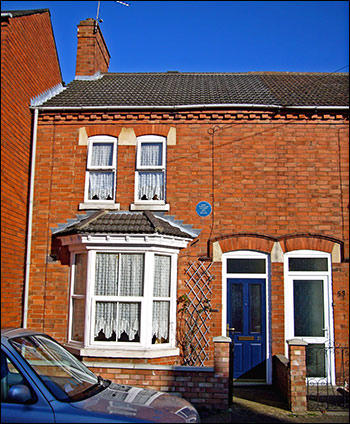 |
|
16
|
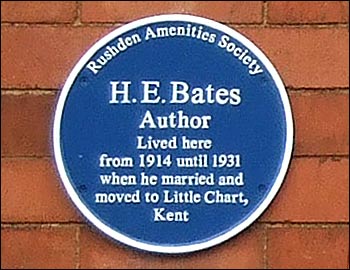 Another plaque was unveiled on 16th May 2012, by the Amenities Society, on 15 Essex Road, where H E Bates lived there from 1914 until his marriage in 1931. H E and Madge made their home at Little Chart, Kent. He used several buildings in Rushden as locations for some of his novels, most notably Rushden Hall in ‘Hall Park’ as the setting for ‘Love for Lydia’, where the fictional Aspen family lived, and the ’Sanatorium’, later the hospital, where Lydia was a patient for tuberculosis. Another plaque was unveiled on 16th May 2012, by the Amenities Society, on 15 Essex Road, where H E Bates lived there from 1914 until his marriage in 1931. H E and Madge made their home at Little Chart, Kent. He used several buildings in Rushden as locations for some of his novels, most notably Rushden Hall in ‘Hall Park’ as the setting for ‘Love for Lydia’, where the fictional Aspen family lived, and the ’Sanatorium’, later the hospital, where Lydia was a patient for tuberculosis.
|
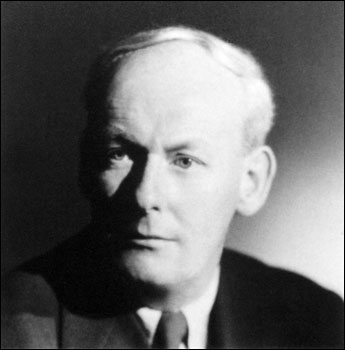 |
|
17
|
Continue down Essex Road, turn right into Park Road, take the third turning on the left into Griffiths Street. At the end of Griffith Street turn left into High Street South and proceed. Just past the Conservative Club on your right is No 46.
Bernard Vann was a man who excelled in every aspect of life, from his schooldays until his death in 1918. He was born on the 9th July 1887, educated at Chichele Grammar School Higham Ferrers and later at Jesus College Cambridge. He played ‘Soccer,’ Cricket and Hockey, becoming captain in all three sports. He played soccer for Derby County and Northampton Town, and hockey for Leicestershire. In September 1910 he was ordained at Peterborough and then became chaplain at Wellingborough School, where he taught history and theology; and coached the pupils in football and cricket. His Victoria Cross was awarded for bravery in the attack at Bellienglise and Lehaucourt on September 29th 1918. Four days later he was killed in another battle, and was buried in the British cemetery at Bellincourt with the Victoria Cross engraved on the headstone. He is also commemorated on the War Memorial in Rushden and at Wellingborough School. [To his memory a road was named Bernard Vann Close in 2016]
|
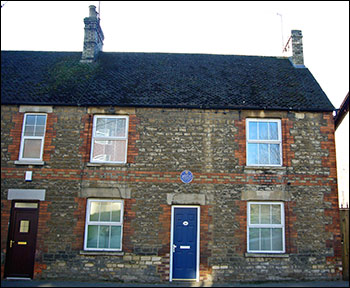 |
|
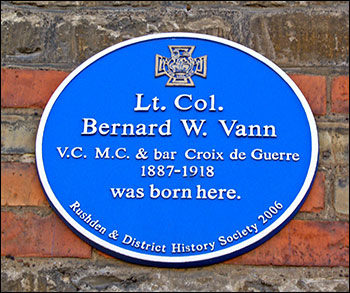 |
| 17a |
Walk back towards the park. In the park is Rushden Hall, parts of which date back to the Jacobean era.
The plaque, unveiled in 2016 by local historian, Clive Wood, has brief details of the Hall's history.
|
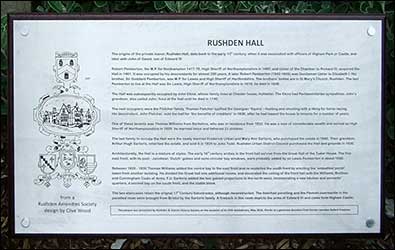 |
| 17b |
Return to the park entrance, turn left toward the traffic lights.
Just before the traffic lights, this plaque is to commemorate the Ginns family, who were blacksmiths with a forge on this site. The business continued for 80 years under the Ginns family, and with Jimmy Guinee who took over in 1950, for the last 22 years.
|
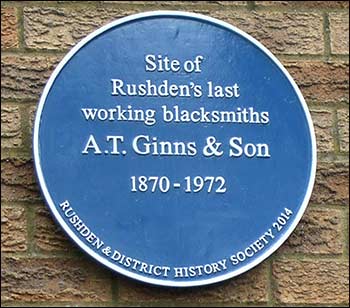 |
| 18 |
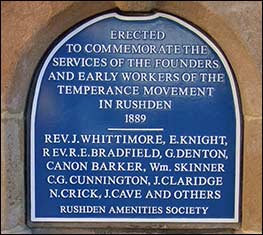 Cross over at the traffic lights and go down Skinners Hill. On your right and at the lower rear corner of the War Memorial garden is a plaque commemorating the Temperance Society. Cross over at the traffic lights and go down Skinners Hill. On your right and at the lower rear corner of the War Memorial garden is a plaque commemorating the Temperance Society.
A memorial drinking fountain was installed in 1889 to the founders of the Temperance Society. In 2013 the stone work of the War Memorial and Temperance Memorial was cleaned. In October 2013 the Amenities Society installed a blue plaque over the original lettering, which was heavily worn, repeating the inscription.
The drinking fountain was removed about fifty years earlier.
|
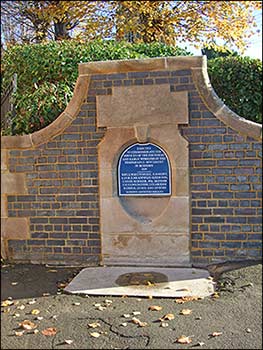 |
|